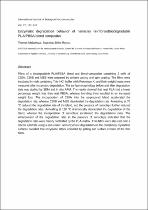 ResearchSpace
ResearchSpace
Enzymatic degradation behavior of nanoclay reinforcedbiodegradable PLA/PBSA blend composites
JavaScript is disabled for your browser. Some features of this site may not work without it.
- ResearchSpace
- →
- Research Publications/Outputs
- →
- Journal Articles
- →
- View Item
| dc.contributor.author |
Malwela, T

|
|
| dc.contributor.author |
Ray, SS

|
|
| dc.date.accessioned | 2016-06-27T08:36:22Z | |
| dc.date.available | 2016-06-27T08:36:22Z | |
| dc.date.issued | 2015-06 | |
| dc.identifier.citation | Malwela, T. and Ray, S.S. 2015. Enzymatic degradation behavior of nanoclay reinforcedbiodegradable PLA/PBSA blend composites. International Journal of Biological Macromolecules, 77, 131-142 | en_US |
| dc.identifier.issn | 0141-8130 | |
| dc.identifier.uri | http://www.sciencedirect.com/science/article/pii/S0141813015001701 | |
| dc.identifier.uri | http://hdl.handle.net/10204/8569 | |
| dc.description | Copyright: 2015 Elsevier. Due to copyright restrictions, the attached PDF file only contains the abstract of the full text item. For access to the full text item, please consult the publisher's website. The definitive version of the work is published in International Journal of Biological Macromolecules, 77, 131-142 | en_US |
| dc.description.abstract | Films of a biodegradable PLA/PBSA blend and blend-composites containing 2 wt% of C20A, C30B and MEE were prepared by solvent casting and spin coating. The films were incubated in vials containing Tris–HCl buffer with Proteinase K, and their weight losses were measured after enzymatic degradation. The surface morphology before and after degradation tests was studied by SEM and in situ AFM. The results showed that neat PLA had a lower percentage weight loss than neat PBSA, whereas blending them resulted in an increased weight loss. The incorporation of C20A into the as-prepared blend accelerated the degradation rate, whereas C30B and MEE decelerated the degradation rate. Annealing at 70 °C reduced the degradation rate of the blend, and the presence of nanoclays further reduced the degradation rates. Annealing at 120 °C dramatically decelerated the degradation of the blend, whereas the incorporation of nanoclays accelerated the degradations rates. The enhancement of the degradation rates in the presence of nanoclays indicated that the degradation rates were mainly controlled by the PLA matrix. Thin films were also cast onto a silicon substrate using a spin coater, and enzymatic degradation on the completely crystalline surfaces revealed that enzymatic attack occurred by pitting and surface erosion of the thin films. | en_US |
| dc.language.iso | en | en_US |
| dc.publisher | Elsevier | en_US |
| dc.relation.ispartofseries | Workflow;16399 | |
| dc.subject | Biodegradable blend | en_US |
| dc.subject | Organoclay | en_US |
| dc.subject | Enzymatic degradation | en_US |
| dc.title | Enzymatic degradation behavior of nanoclay reinforcedbiodegradable PLA/PBSA blend composites | en_US |
| dc.type | Article | en_US |
| dc.identifier.apacitation | Malwela, T., & Ray, S. (2015). Enzymatic degradation behavior of nanoclay reinforcedbiodegradable PLA/PBSA blend composites. http://hdl.handle.net/10204/8569 | en_ZA |
| dc.identifier.chicagocitation | Malwela, T, and SS Ray "Enzymatic degradation behavior of nanoclay reinforcedbiodegradable PLA/PBSA blend composites." (2015) http://hdl.handle.net/10204/8569 | en_ZA |
| dc.identifier.vancouvercitation | Malwela T, Ray S. Enzymatic degradation behavior of nanoclay reinforcedbiodegradable PLA/PBSA blend composites. 2015; http://hdl.handle.net/10204/8569. | en_ZA |
| dc.identifier.ris | TY - Article AU - Malwela, T AU - Ray, SS AB - Films of a biodegradable PLA/PBSA blend and blend-composites containing 2 wt% of C20A, C30B and MEE were prepared by solvent casting and spin coating. The films were incubated in vials containing Tris–HCl buffer with Proteinase K, and their weight losses were measured after enzymatic degradation. The surface morphology before and after degradation tests was studied by SEM and in situ AFM. The results showed that neat PLA had a lower percentage weight loss than neat PBSA, whereas blending them resulted in an increased weight loss. The incorporation of C20A into the as-prepared blend accelerated the degradation rate, whereas C30B and MEE decelerated the degradation rate. Annealing at 70 °C reduced the degradation rate of the blend, and the presence of nanoclays further reduced the degradation rates. Annealing at 120 °C dramatically decelerated the degradation of the blend, whereas the incorporation of nanoclays accelerated the degradations rates. The enhancement of the degradation rates in the presence of nanoclays indicated that the degradation rates were mainly controlled by the PLA matrix. Thin films were also cast onto a silicon substrate using a spin coater, and enzymatic degradation on the completely crystalline surfaces revealed that enzymatic attack occurred by pitting and surface erosion of the thin films. DA - 2015-06 DB - ResearchSpace DP - CSIR KW - Biodegradable blend KW - Organoclay KW - Enzymatic degradation LK - https://researchspace.csir.co.za PY - 2015 SM - 0141-8130 T1 - Enzymatic degradation behavior of nanoclay reinforcedbiodegradable PLA/PBSA blend composites TI - Enzymatic degradation behavior of nanoclay reinforcedbiodegradable PLA/PBSA blend composites UR - http://hdl.handle.net/10204/8569 ER - | en_ZA |





